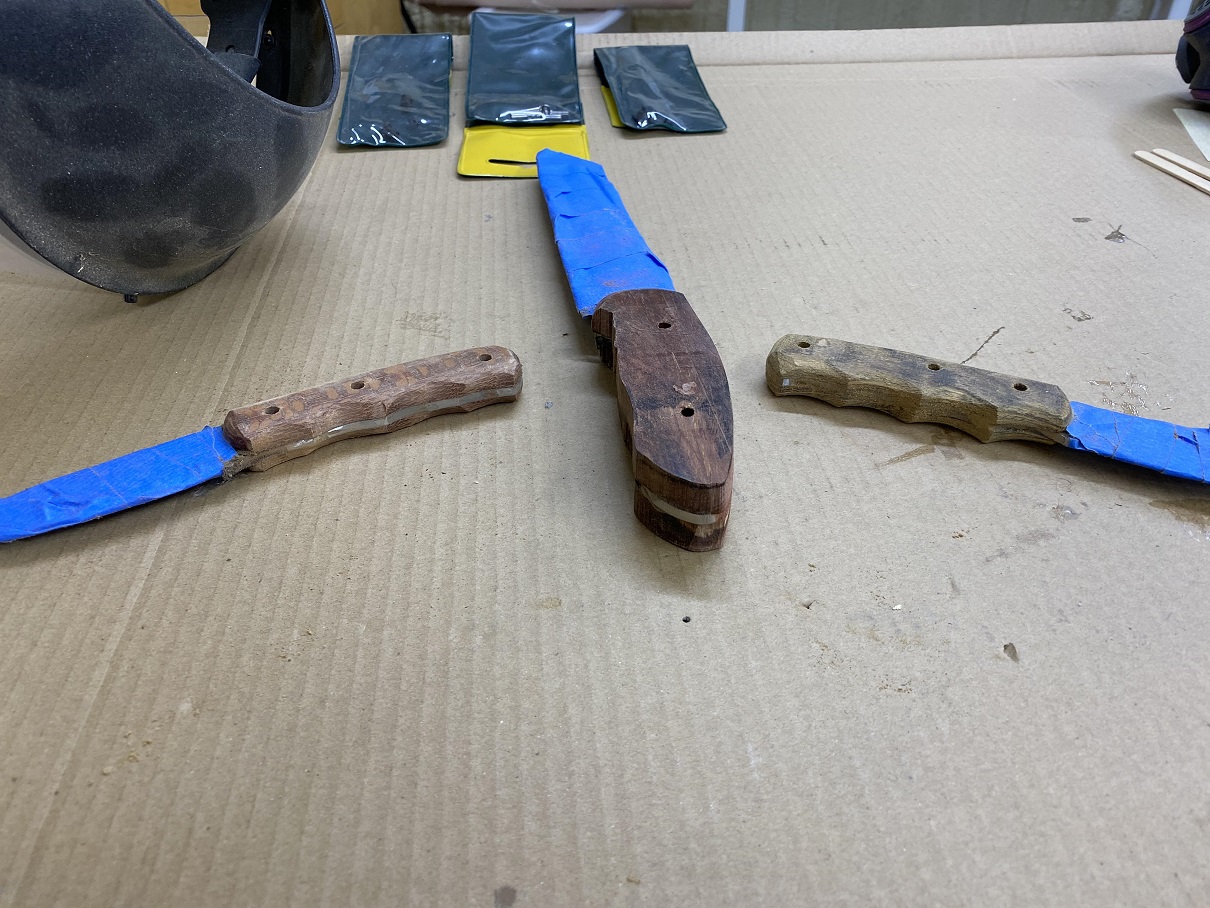04-04-2021, 10:37 PM
Came out this morning and took the "knives" out of the clamps. They were solid. First step was a trip to the drill press to drill the holes for the screws all the way thru using the existing holes in the off side scales as a guide. Carefully aligning each hole, with care to insure the knife was flat on the drill press, boom. All the holes were done. I went slow and took my time. We are about halfway there.
Before starting on the shaping here, we will tape up the blades to insure safety, I don't want a knife twisting in my hand and cutting me. I leave the plastic sleeve in place and add a couple layers of blue painters tape. Insurance. CHEAP insurance.


Next up was setting up the 1x30 with the 60 grit to start the shaping process. This is the part where we begin shaping those rough scales to the blanks. I love this part. Not only do the knives start to take shape, but this is were we start to actually see what the scales have been hiding from us. We see a dramatic change in this first step. In the picture below, the two drop points have been shaped, but the Tanto is waiting. Note the difference in the shapes.


Spent thirty to forty five minutes on each knife. The first one up was the Lacewood, and you can tell by the uneven bottom edge where I started and that I didn't have the feel for the technique of using belt crossing the top of the wheel to do the rounded portions. It worked much better on the cocobolo drop point. I had a better feel for control. You will see when I dressed them up in the passes on the 100 grit.
The sixty grit passes completed. The grains are starting to show and the shapes are revealing themselves.


I got back out after lunch, and hit them with the 100 grit. I spent a lot of time shaping and smoothing, and I did manage to correct the waves that were running across the bottom of the lacewood knife. It's looking a lot better. I will watch to insure I don't (try not to) make that mistake in the future. One second of inattention and the sander can pull the blank across the belt and a fine point is flat.


There is a lot more to do. I will at least go 220 and 400, maybe even 600 or 800. I doubt these will see the 1000.

So far so good. There will be some handwork in the tight areas with thin cut strips, light shining shoes.
Before starting on the shaping here, we will tape up the blades to insure safety, I don't want a knife twisting in my hand and cutting me. I leave the plastic sleeve in place and add a couple layers of blue painters tape. Insurance. CHEAP insurance.

Next up was setting up the 1x30 with the 60 grit to start the shaping process. This is the part where we begin shaping those rough scales to the blanks. I love this part. Not only do the knives start to take shape, but this is were we start to actually see what the scales have been hiding from us. We see a dramatic change in this first step. In the picture below, the two drop points have been shaped, but the Tanto is waiting. Note the difference in the shapes.

Spent thirty to forty five minutes on each knife. The first one up was the Lacewood, and you can tell by the uneven bottom edge where I started and that I didn't have the feel for the technique of using belt crossing the top of the wheel to do the rounded portions. It worked much better on the cocobolo drop point. I had a better feel for control. You will see when I dressed them up in the passes on the 100 grit.
The sixty grit passes completed. The grains are starting to show and the shapes are revealing themselves.

I got back out after lunch, and hit them with the 100 grit. I spent a lot of time shaping and smoothing, and I did manage to correct the waves that were running across the bottom of the lacewood knife. It's looking a lot better. I will watch to insure I don't (try not to) make that mistake in the future. One second of inattention and the sander can pull the blank across the belt and a fine point is flat.

There is a lot more to do. I will at least go 220 and 400, maybe even 600 or 800. I doubt these will see the 1000.

So far so good. There will be some handwork in the tight areas with thin cut strips, light shining shoes.
Jim in Okie
You can tell a lot about the character of a man -
By the way he treats those who can do nothing for him.
You can tell a lot about the character of a man -
By the way he treats those who can do nothing for him.











